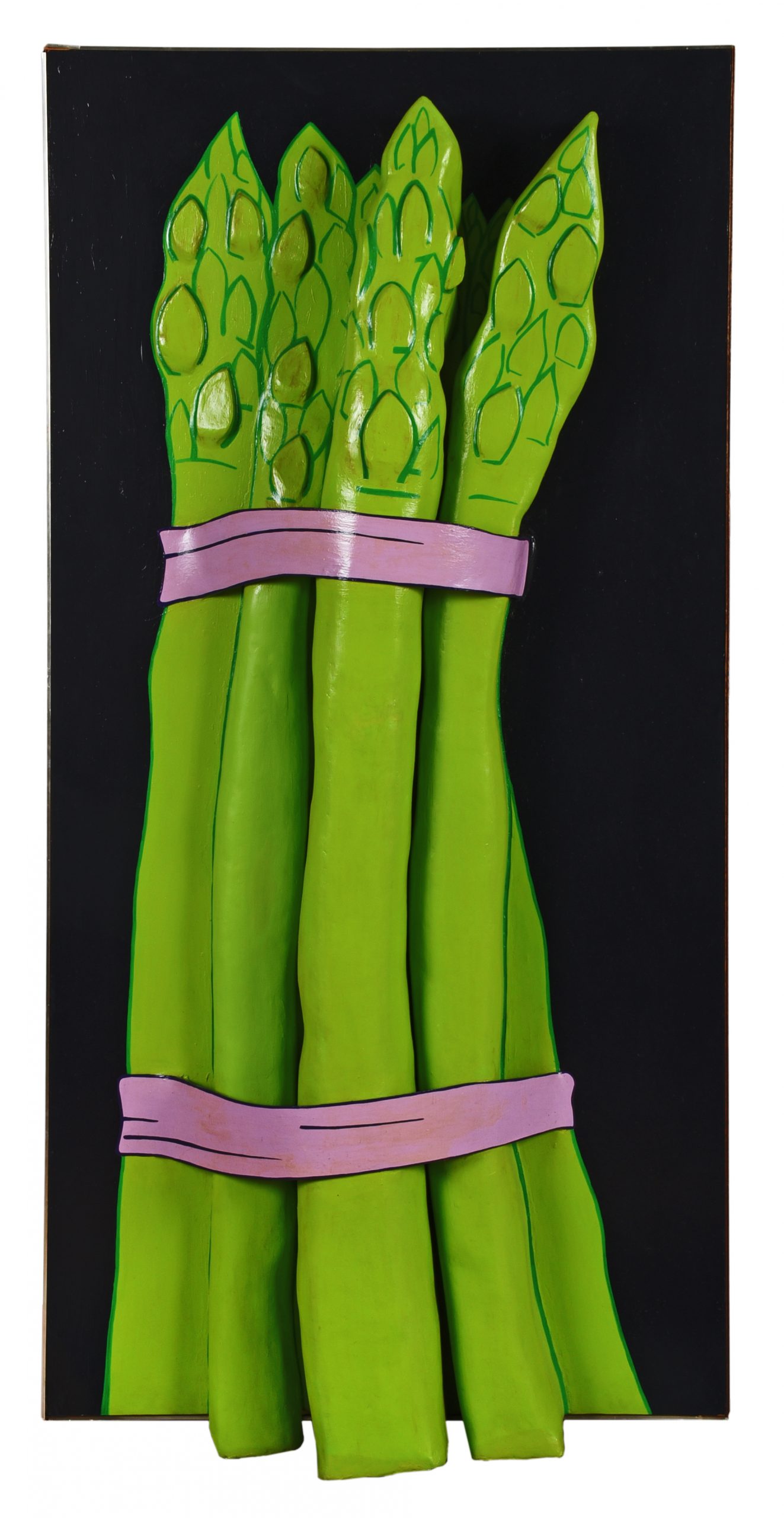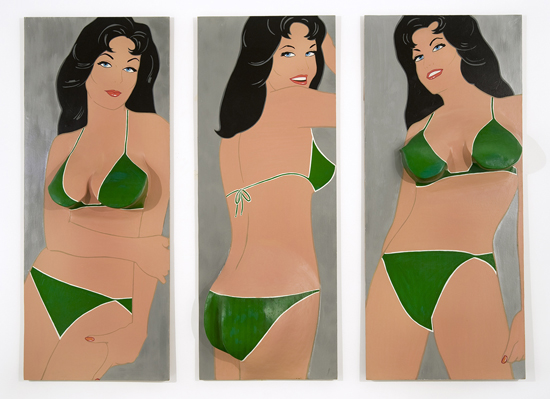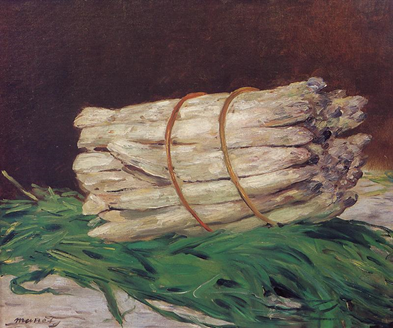Woman in a Man’s World: Trailblazing Pop Artist Marjorie Strider | May 20, 2023

Back in the 1960s, when Marjorie Strider first began showing her work, she was only one of a few female Pop artists. On par with the male leaders in the field, Strider broke boundaries by developing a signature technique and using it to challenge societal norms about women. Similar to her male contemporaries, the Oklahoma-born artist depicted everyday subjects with crisp minimal outlines and bright bold color. She stands alone, however, for creating works that erupt from the flat plane in a unique hybrid of painting and sculpture that she called “build-outs.” Her paintings hang on the wall, but elements burst from the canvas to protrude into the room. Flowers bloom in three dimensions. Peas pop from the pod. In one of her most iconic pieces, a woman lasciviously bites a radish which bulges from her lips. Strider constructed everything herself, enjoying the physicality of her efforts, sometimes proudly leaving the nail heads on view. Originally she carved her “build-outs” from wood and plaster but later utilized newer materials like styrofoam or polyurethane.

Marjorie Strider, “Green Triptych, 1963”
Marjorie Strider debuted her build-outs at the acclaimed 1964 International Girlie Show held at the Pace Gallery in New York City where she joined the likes of Roy Lichtenstein and Andy Warhol to portray pin-up girls. For this show, she “built-out” the curves of bikini-clad women to satirize the sexual objectification found in men’s magazines. Using her method as a metaphor, Strider asserted sexual power by describing her slightly menacing figures as intentionally in your face. The racy radish painting became the Pace group show’s banner image.
Strider went on to have two later solo exhibitions at Pace where she added eroticized images of flowers and vegetables to her “Girlie” paintings. Her “Vegetables” series fits right in with today’s sexual connotation of the eggplant emoji found peppered throughout Instagram. Realistic in color, shape, and composition, the flower and vegetable paintings are abstracted by their large scale. Today, Strider’s paintings that were exhibited at Pace Gallery are the most sought after by collectors.

“Green Vertical,” lot 188 in Brunk Auction’s sale of the collection of Jim and Jean Barrow to be held on May 20, 2023, was part of the “Vegetables” series that sold out at her first solo show at Pace in 1965. On its face, the asparagus stalks, apart from their monumental size, appear like ones the average housewife could buy at a supermarket, yet the plump stalks strain against the pink rubbers which encircle them with an unmistakable undertone.

Edouard Manet, “Bunch of Aspagaus,” 1880
With this piece, Strider also slyly alluded to her formal art history training. “Green Vertical” is a tongue-in-cheek update to the 1880 Impressionist classic “Bunch of Asparagus,” by Edouard Manet. Both artists painted isolated asparagus stalks lushly and larger than life against a dark background, eschewing a plate. But there is more to the story than simply a riff on composition. One could argue that Strider chose her subject matter because of what happened after Manet sold his painting. Manet’s buyer, a prominent real estate financier, overpaid him by 200 francs. Rather than keep the money, Manet sent over a small painting of a single asparagus stalk with a note reading “This one was missing from your bunch”[1]. It is certainly possible that Marjorie Strider used “Green Vertical” to suggest that she would not be in debt to anyone, or perhaps that she (and women generally) were missing from the (male) bunch.
After her heyday in the 1960s, Marjorie Strider fell into relative obscurity but continued working throughout her life—always pushing boundaries with her experimental hybrid technique. Water and other overflowing liquids are seen frequently in her later works. Overall, her art suggests one who refused to be boxed in despite the constraints she faced in conventional society.
Recently, Marjorie Strider has been given the recognition she has long deserved. She was featured prominently in Pop Art retrospectives at the Brooklyn Museum in 2011, the Walker Art Center in 2015, and the Jewish Museum in 2022. In the last six months, Galerie Gmurzynska, a prominent international art gallery with locations in Switzerland and New York, mounted a solo show featuring her female figures that was wildly popular. Opening in November 2022, it was originally scheduled to close the following January but was extended to April due to popular demand. Strider discussed the pressures of being a female in a male’s world in a 2004 interview with Jonathan Gams, published in his book Marjorie Strider: Dramatic Gestures. She said, “I believed those men who either outright said or alluded to the fact that women weren’t good enough to compete in the real art world…But thank God it didn’t stop me from working. I’ve always worked intensely.”[2] Yes, thank God.
—Lynn Byrne, Independent Scholar
[1]https://www.baltimoresun.com/news/bs-xpm-2001-02-18-0102180322-story.html, retrieved March 28, 2023.
[2]https://www.nytimes.com/2014/09/07/arts/design/marjorie-strider-sly-pop-artist-is-dead-at-83.html, retrieved March 28, 2023.
Additional Sources:
https://artmap.com/broadway1602/exhibition/marjorie-strider-2015
https://www.christies.com/en/lot/lot-5354245
https://artcritical.com/2011/03/22/marjorie-strider/
https://www.artforum.com/print/reviews/202303/marjorie-strider-90154
https://www.baltimoresun.com/news/bs-xpm-2001-02-18-0102180322-story.html
https://www.hollistaggart.com/artists/157-marjorie-strider/
https://www.nytimes.com/2022/07/21/arts/design/jewish-museum-pop-art.html
https://www.gmurzynska.com/exhibitions/marjorie-strider-girls-girls-girls/press-release
https://www.nytimes.com/2014/09/07/arts/design/marjorie-strider-sly-pop-artist-is-dead-at-83.html
World-Class Consignments and Exceptional Results